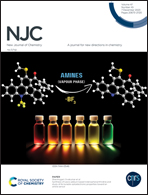Design and development of a Sb2WO6/graphene oxide (2D) nanocomposite as novel electrochemical metal-ion sensor and improved photocatalyst for the degradation of tetracycline†
Abstract
This study describes the single-step solvothermal synthesis of hierarchical orthorhombic Sb2WO6 nanostructures on layered graphene oxide (GO) and the utilization of the resulting product for heavy-metal-ion sensing and visible-light-driven photocatalysis. The adopted strategy generated a nanocomposite with improved interfacial contact among Sb2WO6 hierarchical structures and GO sheets, resulting in enhanced photocatalytic activity with faster charge relocation and attenuated charge-carrier recombination. PXRD, FTIR, SEM, TEM, DRS, and XPS techniques were used to characterize the synthesized pristine (Sb2WO6) and its hybrid nanocomposite with GO. A two-dimensional nest-like Sb2WO6/GO nanocomposite modified glassy carbon electrode was developed as a novel electrochemical sensor towards Hg2+ and UO22+ detection using cyclic voltammetry and differential pulse voltammetry methods under the limits of detection of 0.0038 μM and 0.014 μM, respectively. The Sb2WO6/GO sensor displayed good electrochemical stability through achieving consistent current measurements over time. The evaluated electrochemical parameters of Sb2WO6/GO indicated its photocatalytic desirability, which was then explored in the degradation of tetracycline in an attempt to combat antibiotic resistance. Tetracycline is a ubiquitous drug; however, with its widespread use and bad disposal practices, it is an emergent water contaminant that is posing growing concerns for aquatic ecosystems and a consequent threat of antibiotic resistance. Tetracycline degradation is an important water treatment application on account of its aquatic ecosystem sustainability and prevention of antibiotic resistance as a crucial worldwide health concern.



 Please wait while we load your content...
Please wait while we load your content...